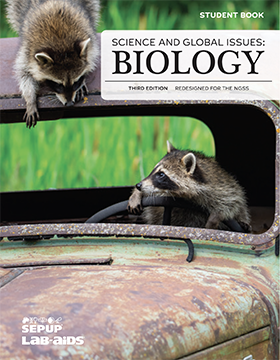SGI: Teachers Activity Links Third Edition
Teacher Activity Links & Downloads
Select any unit from contents
Sustainability: Changing Human Impact
Activity 1 Changing Landscapes (Extension)
Activity 2 Measuring Human Impact (Engineering Extension)
Activity 1
Changing Landscapes (Extension)
Tree Cover Changes in American South
Activity 2
Measuring Human Impact (Engineering Extension)
Digital Innovations to Improve Soil Health
Natural Resource Management and Technology
Technology: The Future of Agriculture
^ top
Ecology: Living on Earth

Activity 1 Establishing a Baseline
Activity 3 Factors Affecting Population Size
Activity 8 Life in the Dark
Activity 10 Crossing Ecosystem Boundaries
Activity 13 Ecosystems at the Tipping Point
Activity 14 The Great Lakes Ecosystem
Activity 15 Overfishing: Is Aquaculture a Solution?
Activity 17 Vertical Ocean Farming
Activity 1
Establishing a Baseline
Wild Rice Quadrat Sampling Simulation
Activity 3
Factors Affecting Population Size
The Song Sparrows of Mandarte Island
Activity 8
Life in the Dark
2016 Deepwater Exploration of the Marianas: NOAA Office of Ocean Exploration and Research
May 2, 2016, Dive 11: Hydrothermal Vent
Activity 10
Crossing Ecosystem Boundaries
Activity 13
Ecosystems at the Tipping Point
Aral Sea Video is found on both of these websites:
Aral: The Lost Sea (We Are Water Foundation)
Aral: The Lost Sea (YouTube)
Activity 14
The Great Lakes Ecosystem
How Chicago Reversed Its River: An Animated History
Great Lakes Research Links – Annotated
The Story
Asian Carp: Threats to the Lower Great Lakes and St. Lawrence River?
Moderate length, approximately mid-upper high school reading level.
Asian carp: how one fish could ruin the Great Lakes
Short article, some pop-ups and ads that students may find distracting. Lower high school reading level.
Asian Carp in the Great Lakes
Scrollable format, good visuals, lower high school reading level.
Great Lakes Invasive Species: 180 and Counting
Broader focus (not just carp). Short article, lower high school reading level.
Great Lakes Fishery Commission – Asian Carp
Includes a video. Article is short, mid-high school reading level.
Asian Carp & the Great Lakes
A series of short audio files and brief articles. Articles are middle school to lower high school reading level. Ideal for students who might prefer listening to the information.
What would happen to the ecosystem?
New Study Finds Asian Carp Threat to Lake Michigan Is Greater Than Previously Thought
Focuses on ecological impact of potential invasion; suggests severe consequences. Short article with lower high school reading level, links to published scientific study.
Asian Carp Would Have Adequate Food to Survive in Lake Michigan
Focuses on feeding behavior of carp and why it will thrive. Short article with lower high school reading level.
Asian carp have never breached a body of freshwater the size of Lake Michigan. Here’s the bizarre way they could survive and thrive in the world’s fifth largest lake.
Focuses on feeding behavior of carp and why it will thrive. Medium length article with a built-in option to listen to the article via a text reader. Page has ads that students may find visually distracting.
Invasive carp fueled by mussel poop could spread across Lake Michigan
Focuses on feeding behavior of carp and why it will thrive. Medium length article at a middle school to lower high school reading level.
Asian carp may cause Lake Erie fish to decline
One of the few articles to predict lesser extreme outcomes. Short article at lower high school reading level. Several interesting visuals of the food web and graphs predicting effects on various species.
Facts About Invasive Bighead and Silver Carps
Written as a fact sheet instead of an article format. Lower high school reading level. Includes a selected references list for published scientific journal articles.
Detection and mitigation efforts (including cost)
Asian carp DNA found in Lake Calumet, only 7 miles from Lake Michigan
ocuses on detection methods and how much money is being spent on it because of threat. Medium length article with a built-in option to listen to the article via a text reader. Page has ads that students may find visually distracting.
Asian Carp Risk Assessment : Great Lakes Region
Focuses on how assessment is being done, and what variables are being measured. Short article. Lower to middle high school reading level.
Great Lakes Fishery Commission Eforum
Focuses on the different organizations that are addressing the issue, and what is being done. Medium length article. Lower to middle high school reading level.
Asian Carp Control
Transcript of expert testimony to a congressional committee. Comprehensive in that it discusses the ecological impact, but it has a lot of discussion of the economic impact and the cost of mitigation and control. Upper high school reading level.
Keeping Asian carp out of the Great Lakes will cost billions and take decades
Focus on economic impact and cost of control. Medium length article. Lower high school reading level.
Stopping Asian Carp
Focuses on preventing invasion. Medium length article. Lower high school reading level.
Assessment of Asian carp in Illinois waterways
Focuses on monitoring, what is working, what is not working. Longer article. Good visuals. Middle high school reading level.
Economic impact on Fisheries
Socio-Economic Impact of the Presence of Asian Carp in the Great Lakes Basin
Executive summary for a much more extensive formal report (linked to on the page). Longer article. Mid-upper high school reading level.
Great Lakes Fishery Commission – The Fishery
Not about carp, but talks about the dollar value of Great Lakes Fisheries. Moderate length article. Middle school to lower high school reading level.
Asian Carp and the Great Lakes Region
Very comprehensive, long article, but has sections that are clearly titled and easy to navigate as well as clear data tables. Middle high school reading level.
Activity 15
Overfishing: Is Aquaculture a Solution?
How Seafood is Farmed: Open Net Pens or Cages
Activity 17
Vertical Ocean Farming
Vertical ocean farming – the least deadliest catch | Bren Smith | TEDxBermuda
^ top
Cells: Improving Global Health
Activity 1 Survival Needs
Activity 2 Everyday Hydration
Activity 3 Homeostasis Disrupted
Activity 4 Body Systems in Balance
Activity 6 What Do Specialized Cells Do?
Activity 8 Feedback Loops in Humans
Activity 10 Burning Calories
Activity 13 Feeding the World’s Population
Activity 15 Energy for Life
Activity 1
Survival Needs
Weather Related Fatality and Injury Statistics
A link to the most current data available on weather-related fatalities can be found on the U.S.
Natural Disasters and Severe Weather
Additional information on how weather events can impact human health and resources and how to prepare for natural disasters and severe weather.
Activity 2
Everyday Hydration
SEPUP Simulation: Modeling Cell Structure and Function
Activity 3
Homeostasis Disrupted
Our World in Data – Causes of Death
A link to the most current data available on leading causes of death world-wide
Activity 4
Body Systems in Balance
Our World in Data – Burden of Disease
A link to the most current data available on the global burden of disease.
Activity 6
What Do Specialized Cells Do?
SEPUP Simulation: Modeling Cell Structure and Function
SEPUP Simulation: What Do Specialized Cells Do?
Activity 8
Feedback Loops in Humans
Our World in Data – Upper Respiratory Death by Age
A link to the most current data available on global death rates from upper respiratory illnesses by age.
Activity 10
Burning Calories
Feel the Burn: How Do Scientists Count Calories?
Activity 13
Feeding the World’s Population
Climate Science and Effects
A source for more current data on climate effects on the food supply can be found here.
Activity 15
Energy for Life
SEPUP Simulation: Photosynthesis and Cellular Respiration Simulation
^ top
Genetics: Feeding the World
Activity 1 Superweeds: Where Did They Come From? (Extension)
Activity 2 Creating Genetically Modified Bacteria (Engineering Extension)
Activity 3 Mitosis and Asexual Reproduction
Activity 7 Protein Synthesis: Transcription and Translation
Activity 8 Cell Differentiation and Gene Expression (Extension)
Activity 11 Meiosis and Sexual Reproduction
Activity 13 Which Plant is Genetically Modified (Extension)
Activity 15 Benefits and Trade-offs of Genetically Modified Organisms (Engineering Extension)
Activity 1
Superweeds: Where Did They Come From? (Extension)
Will Rising Temperatures Make Superweeds Even Stronger?
International Survey of Herbicide Resistant Weeds
Australia Might Have the Answer to Herbicide Resistant Superweeds
Activity 2
Creating Genetically Modified Bacteria (Engineering Extension)
First Genetically Modified Mosquitoes Released in the United States
The U.S.’s First Open-Air Gentically Modified Mosquitoes Have Taken Flight
CDC Information Sheet: Genetically Modified Mosquitoes
Activity 3
Mitosis and Asexual Reproduction
SEPUP Simulation: Mitosis and Meiosis
Click on the link above to go to the Mitosis and Meiosis simulation.
Activity 7
Protein Synthesis: Transcription and Translation
SEPUP Simulation: Protein Synthesis
Click on the link above to go to the Protein Synthesis simulation.
mRNA Vaccines–A New Era in Vaccinology
Understanding mRNA COVID Vaccines
Activity 8
Cell Differentiation and Gene Expression (Extension)
Human Genome is Much More than Just Genes
Activity 11
Meiosis and Sexual Reproduction
SEPUP Simulation: Mitosis and Meiosis
Click on the link above to go to the Mitosis and Meiosis simulation.
Activity 13
Which Plant is Genetically Modified
Polymerase Chain Reaction (PCR) Fact Sheet
Polymerase Chain Reaction (PCR)
Understanding COVID-19 PCR Testing
Activity 15
Benefits and Trade-offs of Genetically Modified Organisms (Engineering Extension)
A Gene-Editing Experiment Lets Those Patients with Vision Loss See Color Again
Three People with Inherited Diseases Successfully Treated with CRISPR
Can CRISPR Cure Sickle Cell Disease
^ top
Evolution: Managing Change
Activity 2 Changing Temperatures
Activity 3 Social Behavior
Activity 6 Increasing Time Scales
Activity 8 The Anthropocene
Activity 9 Evidence and the Theory of Evolution
Activity 13 Shrinking Salmon
Activity 2
Changing Temperatures
Video showing bubbles coming off the stem of Elodea
Video showing bubbles coming off the stem of Ludwigia
Activity 3
Social Behavior
Prairie Dog Video—short video of prairie dogs calling
Prairie Dog Video—longer video of prairie dogs calling
Activity 6
Increasing Time Scales
Anole Speciation Video
– Download
– Streaming
Activity 8
The Anthropocene
Are We Living in the Sixth Extinction?
Video from PBS (9 minutes)
Sixth Mass Extinction In Earth’s History Underway; Scientists Say Humans To Blame
Secondary Source, The Weather Channel
18 signs we’re in the middle of a 6th mass extinction
Secondary Source, Business Insider
Sixth Mass Extinction of Wildlife Accelerating- Study
Secondary Source, Earth.org
Earth Is Not in the Midst of a Sixth Mass Extinction
Secondary Source, The Atlantic
Accelerated modern human–induced species losses: Entering the sixth mass extinction
Primary Source, Science Advances
Vertebrates on the brink as indicators of biological annihilation and the sixth mass extinction
Primary Source, Proceedings of the National Academy of Sciences
Activity 9
Evidence and the Theory of Evolution
Infographics resources
- What is an infographic and how do I create one?
- Online infographics maker—requires registration
- 10 Great Examples of Infographics for Education + Tutorials
Activity 13
Shrinking Salmon
Shrinking Salmon, Fewer Clams: Climate Change Devastating Seafood Industry
Science as a Human Endeavor: Student Page
Link to Science as a Human Endeavor Student Resource Page
^ top

